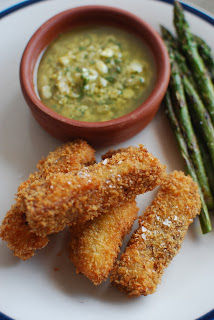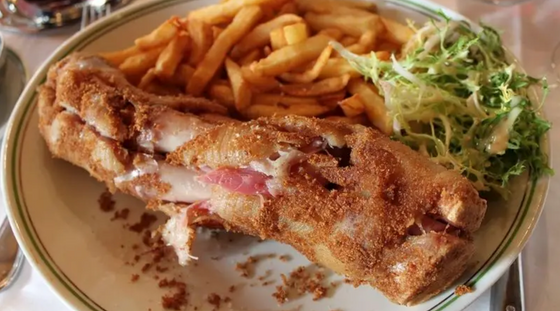
"I only wish I could have cooked it for her, as I know it was one of her favourites. We would have drunk a bottle of old Rhone with it. Maybe two" Simon Hopkinson
You could almost say Saint Elizabeth I guess. She is after all the most likely candidate as patron saint of modern cooking.
Anyway Simon Hopkinson was referring, in an article in The Observer, to her recipe for Breast of lamb Sainte Ménéhould. There is a touching addition to today's leading quote for he goes on to say:

"Only a week before the death of Elizabeth David, I finally prepared Breast of Lamb Ste-Ménéhould."
Many, many years ago, in the first years of our marriage, when money was tight, and when I was sort of learning to cook with the help of my early gurus, I also made this dish. The version shown here is from Simon Hopkinson himself and therefore, I assume, the original Elizabeth David recipe. He says of it:
"This is a remarkable dish because it uses the least glamorous part of the lamb and makes it into something so good that it knocks you for six. The way in which it is cooked removes any notion that this over-fatty cut is going to be indigestible or greasy. The end result is supremely comforting and very savoury." Simon Hopkinson

This is another version of it from the website Essex Eating, which I have to say, looks rather more tempting, and also illustrates how it's generally presented as an entrée, not the main event - which is how I presented it. I confess that all I remember is that it was an enormous faff - so I was relieved to see that Felicity Lawrence, writing in The Guardian concurred by saying that it was "incredibly cheap but labour-intensive".
Mind you when I read the recipe I don't quite see why it was such a faff. Yes it takes a long time. You cook the breast for a long time in the oven with all sorts of delicious things, until the meat literally falls from the bone, but it doesn't require much preparation time. Remove the bones, lay it out under weights in the fridge until cold, then slice, coat with egg and breadcrumbs and grill - today some say fry. Which doesn't sound so hard to me today, because it's just a matter of planning in advance, but I obviously thought it wasn't worth the effort because I didn't try it again. But then again at the time I was a novice cook.
And herewith a quick aside to say that lamb breast is no longer incredibly cheap. Well actually you can't get lamb breast anymore - well not here in Australia. And to be fair, not in a supermarket. An actual butcher, may well be able to provide it. When I looked it up on the Coles and Woolworths websites all I could find was some pet food from Woolworths and lamb bones from Coles.

But this brings me to Sainte Ménéhould, and why I'm talking about this at all. It's guru week is why I'm talking about it, and it's Elizabeth David's turn again, so I turned to the next book on my shelf French Country Cooking, first published in the Penguin edition in 1959 although it was first published in 1951. I see it cost me a mere three shillings and sixpence, which means I bought it in England, but you can pick up a copy for US$66 on the net. A bit less than the Cordon Bleu book I spoke about the other day, but then it has been reprinted many times. I'm sure you can still buy a modern reprint.
At the risk of boring you, herewith a couple of long quotes from her Preface to the Revised Edition which this is (1958), and the original Introduction:
"I am anxious to stress the fact that this little collection gives nor more than an indication of the immense diversity and range of French regional cookery. It is a subject of such scope that half a dozen large volumes of recipes would scarcely exhaust it. Indeed it would be almost impossible ever to compile a complete collection, because in France regional cookery is very much alive, and therefore perpetually evolving. As modern transport, changing agricultural methods and new types of kitchen stoves and utensils make old recipes out of date, so resourceful housewives and enterprising chefs invent new dishes to meet the altered circumstances and to satisfy their own creative instinct where cookery is concerned. But many of these new dishes will be based on the old traditional ones; the ingredients used will be those native to the districts; the local flavour will be preserved. And so it comes about that for the collectors every visit to France will produce some new dish, and those interested enough will find there is always something new to learn about the engrossing subject of French cookery."
"Those who care to look for it, ... will find the justification of France's culinary reputation in the provinces, at the riverside inns, in unknown cafés along the banks of the Burgundy canal, patronised by the men who sail the great petrol and timber barges to and from Marseille ....."
A somewhat romantic view these days I guess. Many country people now shop in hypermarkets, but nevertheless even those hypermarkets have large sections devoted to regional specialities. And tourism, of course, has played a huge part in many regional dishes being discovered, updated and presented in restaurants from the high to the low.

But enough of Elizabeth David. What about Sainte Ménéhould? Here she is. I'm not quite sure where this statue is but I assume it's at least nearby the town of Sainte Ménéhould in the Champagne area of France. Not much is known about her but there is a little bit. Beginning with her name which is actually Manachildes or Manehildis. She was the daughter of Count Sigmar of Perthois and died in the 5th century. They don't seem to know when she was born. But she had six sisters, and actually they were all venerated as virgin saints together. Her sisters names were Lintrudiss, Amee, Pusinna, Francuma, Holdis, and Libergis - names that, as the writer said are not likely to become fashionable anytime soon. In spite of being rich - one assumes they were rich, they dedicated their lives to the sick and the poor and Sainte Ménéhould is credited with creating a miraculous spring to assuage the thirst of the thousands of people who came to visit her and her sisters. At the time the town was called Château-sur-Aisne but was renamed in her honour. Her name/feast day is October 14th. And one more thing - a bit far-fetched I must say - some say that these seven sisters, inspired all those other famous sevens - like Snow White and the Seven Dwarfs. Yes, definitely far-fetched.
Before I get to the food part there are a two or three other things to say about the town itself. It was the birthplace of Dom Perignon, it basically burnt down in 1719 and was completely rebuilt, and it also played a part in the capture of Louis XVI and his family when they attempted to flee from the increasing unrest in the capital. There are a couple of versions of this story, one of which is associated with the original Sainte Ménéhould dish which I shall come to. On the flight the king and his family definitely stopped here to change the horses on their carriage. One version says that stopped to eat the delicious local dish - a favourite of the king's, which delayed their departure and allowed the revolutionaries to catch up to them. The other version has the local postman recognising the king as the horses were being changed, so he went ahead and announced their arrival to the authorities in Varennes where they were arrested. The rest is history as they say.
So what was the local speciality? Well not lamb breast but pig's trotters, and you know I'm now not quite sure whether that long ago dish I cooked was the pig's trotters and not the lamb, because Elizabeth David does have a recipe for them as well. I think the one on the right below is the version still served in the town and seems to have kept the bones in. Hard to tell with the other one.
There is also one of those rather lovely but probably mythical stories about how the dish was conceived:
"The recipe was born, it is said, in the kitchens of the Hôtel de Metz (which no longer exists today). Legend attributes it to the thoughtlessness of a scullion who forgot a pot of feet on the stove for more than a long night. He discovered in the morning that the feet were even better and the bones had an appetizing softness." France Voyage
Which doesn't explain the breadcrumbs, but never mind. It is said to date back to the 15th century and also that "King Charles VII ate pigs feet each time he came in Saint-Menehould!" Anecdotrip Which sounds to me like a mix up with the story of the escaping Louis XVI and family. And pig's trotters are a bit hard to find these days too.

I don't think I shall be making either of these versions for my guru dish however, but I did find that further on in her book Elizabeth David has a chicken version which sounds a whole lot more tempting and a whole lot less work. I found this particular Poulet à la Ste Ménéhould on the Hi Cookery website whose author says it comes from a book called Cooking with the Saints by Ernst Scheugen but it looks more or less exactly like Elizabeth David's. And she suggests doing it with split chicken - and I happen to have half a chicken in the freezer.
I haven't quite made up my mind yet however, Estouffade de Boeuf à la Provençal looks tempting too, and there are probably lots of others. I might have gone for one of her glorious soups, but we just had soup the other day. Still it was a minor trip down memory lane for me plus a little bit of history, religion and storytelling too.
I also found no reference to Sainte Ménéhould in any of my other French cooking books, so the town - which most likely profits from the tourism advantage of a dish named for it - owes Elizabeth David this one.




コメント